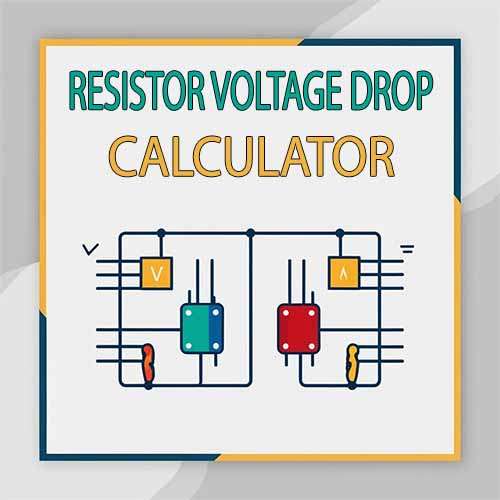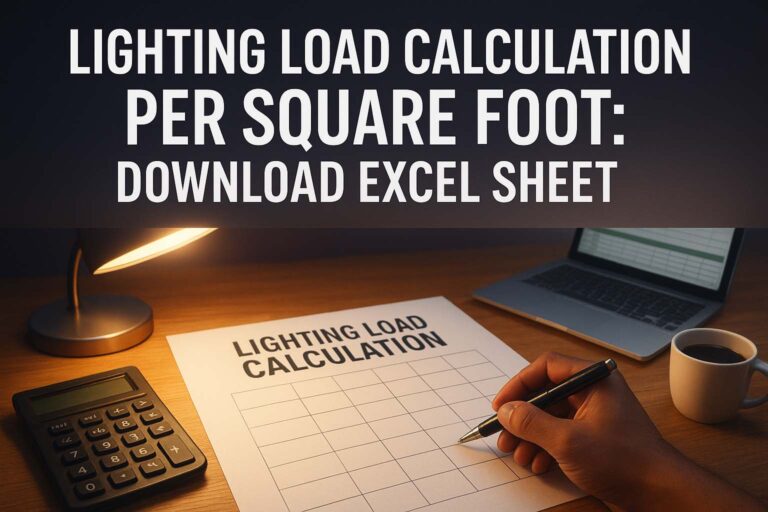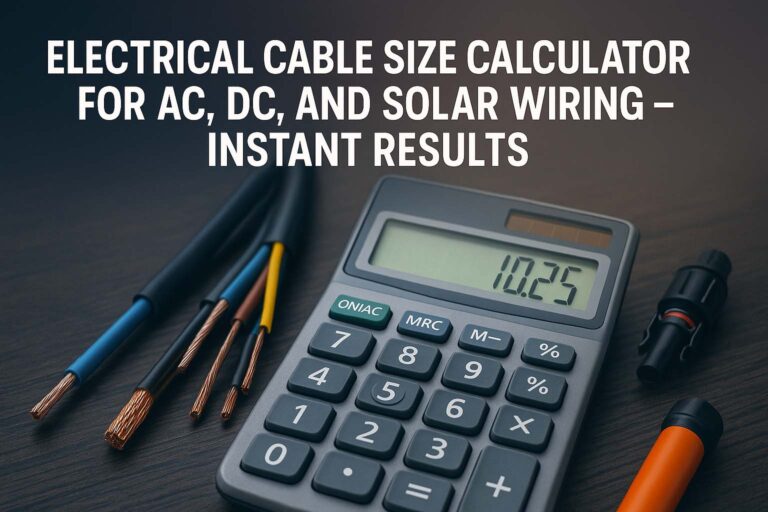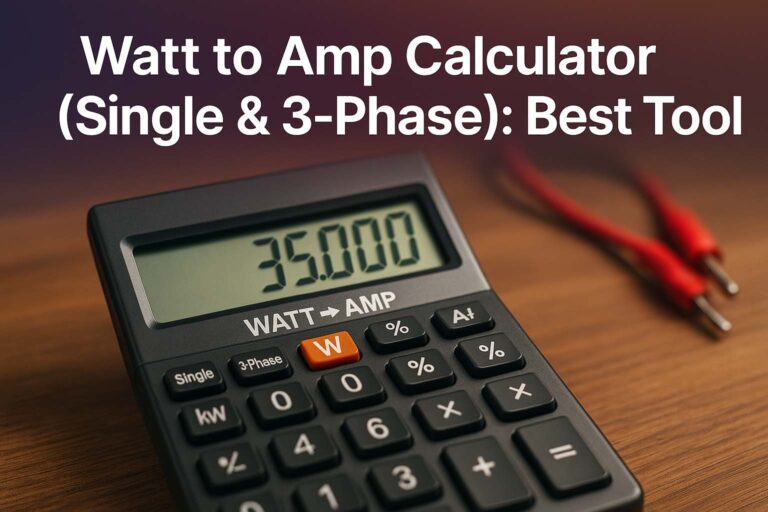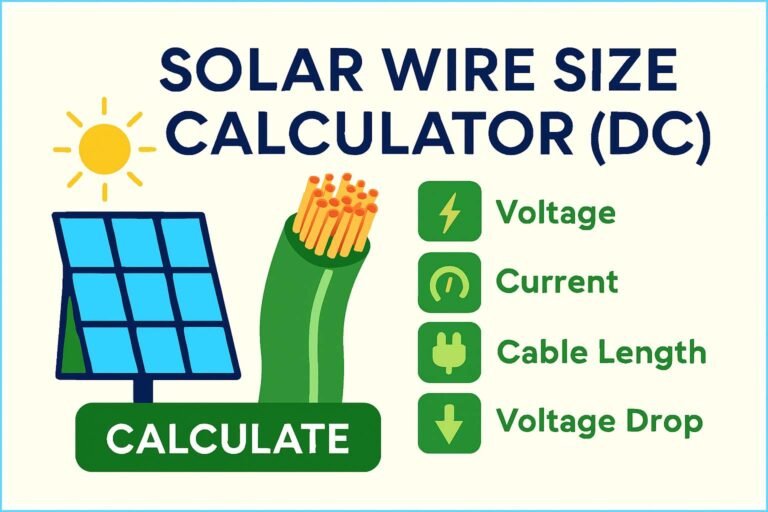3 Phase Motor Circuit Breaker Sizing Calculator
Choosing the correct breaker size for a three-phase motor is critical for both safety and performance. Many engineers, electricians, and technicians struggle with breaker sizing because it involves understanding motor ratings, fault currents, and protection standards. A properly sized breaker ensures that the motor runs efficiently while being protected against overloads and short circuits.
Table of Contents
Table of Contents
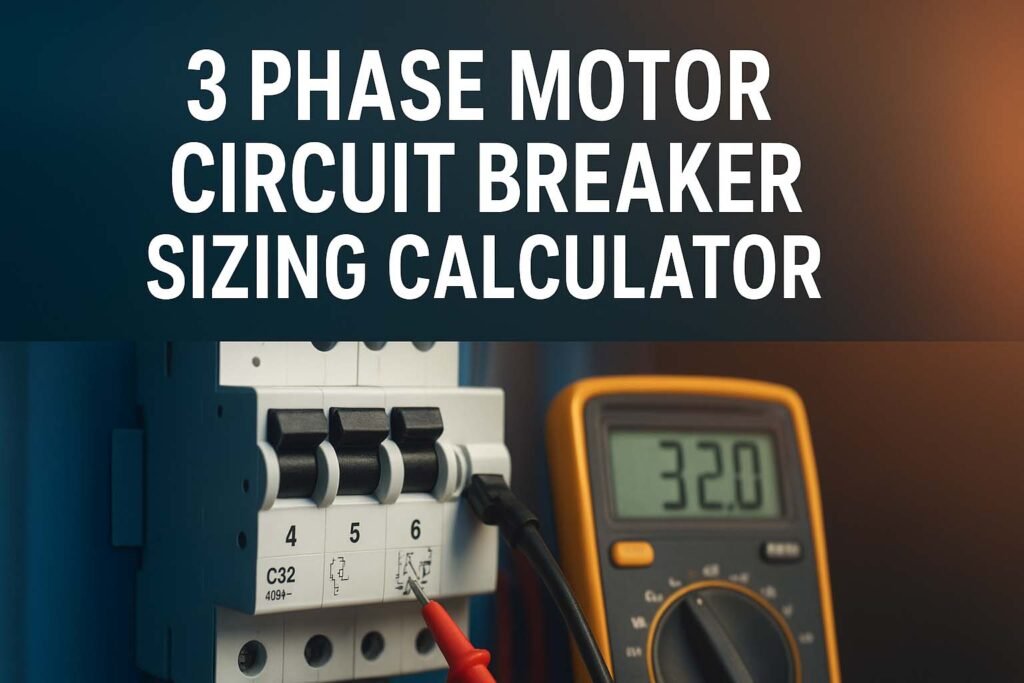
If the breaker is undersized, nuisance tripping will occur, and if it is oversized, the motor will not be adequately protected. That is why using a 3 phase motor circuit breaker sizing calculator is the most reliable way to get accurate results without complex manual calculations. For a general tool that helps across different loads, you can also check our Circuit Breaker Size Calculator which simplifies breaker selection for various applications.
A motor breaker is not just a switch. It is the first line of defense against faults, short circuits, and thermal overloads. Three-phase motors are widely used in industrial, commercial, and even agricultural systems. They consume a large amount of power and need robust electrical protection. The breaker sizing process is guided by international standards like IEC 60947 and NEC (National Electrical Code), which define how breakers should be rated in relation to the motor’s full load current.
Before we dive deeper, let us summarize the key takeaways you will gain from this guide:
- A 3 phase motor circuit breaker sizing calculator helps in quick and accurate selection of breaker ratings.
- Breaker sizing is based on motor horsepower, voltage, full-load current, and service factor.
- Understanding NEC and IEC rules ensures compliance and reliable protection.
- Properly sized breakers prevent both nuisance tripping and equipment damage.
- Using the calculator saves time and reduces risk of human error.
Why Breaker Sizing Matters for Motors
Three-phase motors draw higher starting currents compared to single-phase motors. During startup, the inrush current can be 5–8 times the full load current. If the breaker is not sized to handle this, it will trip every time the motor starts. At the same time, the breaker must not be too large, because then it will not provide protection against overloads and short circuits. The balance is important.
Use our online tool Power Factor Correction Capacitor Calculator – Complete Technical Guide
An undersized breaker means downtime, reduced productivity, and frequent maintenance. An oversized breaker could result in burnt windings, damage to the motor, and even electrical fires. That is why engineers rely on formulas and calculators to determine the correct breaker rating. A 3 phase motor circuit breaker sizing calculator uses the motor’s horsepower, voltage, and efficiency to provide the ideal breaker size.
3 Phase Motor Circuit Breaker Sizing Calculator
Formula for Breaker Sizing in 3 Phase Motors
The breaker size is mainly calculated from the motor’s full load current (FLC). The general formula to calculate FLC is:
I = (HP × 746) ÷ (√3 × V × Efficiency × Power Factor)
Where:
- HP = Motor horsepower
- V = Voltage (line-to-line)
- Efficiency = Motor efficiency (usually 0.85–0.95)
- Power Factor = Typical range 0.8–0.9
Once the full load current is known, breaker sizing follows the NEC recommendation:
Breaker Size = FLC × 125%
This ensures that the breaker can withstand motor starting currents while still protecting against overloads.
Use our online tool Circuit Breaker Size Calculator: Best Tool for Engineers
Example Calculation for a 3 Phase Motor
Consider a 3-phase motor rated at 15 HP, 415V, 0.9 power factor, and 90% efficiency.
Step 1: Calculate FLC
I = (15 × 746) ÷ (√3 × 415 × 0.9 × 0.9)
I ≈ 21.5 A
Step 2: Calculate breaker size
Breaker Size = 21.5 × 1.25
Breaker Size ≈ 26.9 A
So, a 30A breaker would be chosen for this motor.
Standard Motor Breaker Sizes
Instead of using non-standard values, breakers are selected from commercially available ratings. Below is a table that matches motor horsepower with standard breaker sizes for 415V three-phase motors.
| Motor Power (HP) | Full Load Current (A) | Recommended Breaker Size (A) |
|---|---|---|
| 5 HP | 7.6 | 10 A |
| 10 HP | 15.2 | 20 A |
| 15 HP | 21.5 | 30 A |
| 20 HP | 28.6 | 40 A |
| 30 HP | 42.9 | 60 A |
| 40 HP | 57.2 | 70 A |
| 50 HP | 71.5 | 90 A |
These are typical values, and actual breaker selection should always confirm motor efficiency, power factor, and local code requirements. A 3 phase motor circuit breaker sizing calculator automatically adjusts these values based on inputs.
Use our online tool Watt to Amp Calculator (Single & Three-Phase): Best Tool
NEC and IEC Guidelines for Breaker Sizing
The National Electrical Code (NEC) and IEC standards provide detailed guidance for motor protection. According to NEC 430.52, the motor branch-circuit short-circuit and ground-fault protective device shall not exceed 250% of the motor full load current for inverse-time circuit breakers. For IEC standards, IEC 60947 defines utilization categories (AC-3, AC-4) that classify motor duty and corresponding breaker ratings.
The calculator ensures compliance with these standards by applying correction factors. This eliminates guesswork and ensures that installations pass inspection.
Types of Circuit Breakers for 3 Phase Motors
Not all breakers are suitable for motor applications. Some of the common breaker types used with 3-phase motors include:
- MCCB (Molded Case Circuit Breaker) – Suitable for large industrial motors, typically rated up to 2500A.
- MCB (Miniature Circuit Breaker) – Used for small motors and light commercial applications, usually up to 125A.
- Motor Protection Circuit Breaker (MPCB) – Specially designed for motors, combining short-circuit and overload protection in one device.
- Air Circuit Breaker (ACB) – Used in large power distribution systems, suitable for very high-capacity motors.
Choosing the right breaker type is just as important as choosing the correct size. The 3 phase motor circuit breaker sizing calculator gives breaker ratings, but engineers must select the correct breaker category based on application.
Use our online tool AWG to mm² Calculator – Convert Wire Sizes Easily and Accurately
Correction Factors in Breaker Sizing
In real-world installations, breaker sizing must consider additional factors:
- Ambient Temperature: Higher temperatures reduce breaker capacity.
- Altitude: At higher altitudes, air cooling decreases, requiring derating of breakers.
- Service Factor of Motor: Motors with higher service factors may need larger breakers.
- Starting Method: Direct-on-line (DOL) starting requires larger breakers than star-delta or soft starter methods.
These correction factors can significantly change breaker selection. A professional-grade 3 phase motor circuit breaker sizing calculator includes these corrections in its algorithms.
Advantages of Using a Breaker Sizing Calculator
Manual calculations take time and require technical expertise. Errors are common when dealing with multiple motors of different sizes. A calculator simplifies the process. Here are some benefits:
- Accuracy: Eliminates guesswork and ensures proper protection.
- Time-saving: Instant results compared to lengthy hand calculations.
- Standard compliance: Integrates NEC and IEC rules directly.
- Flexibility: Works for different voltages, frequencies, and starting methods.
- Cost efficiency: Prevents oversizing or undersizing, saving both equipment and maintenance costs.
For industries running multiple motors, a 3 phase motor circuit breaker sizing calculator is not just a convenience—it is a necessity.
Common Mistakes in Breaker Sizing
Many installations face issues due to improper breaker selection. Some common mistakes include:
- Choosing a breaker equal to the motor full load current without applying the 125% rule.
- Ignoring starting current, leading to nuisance tripping.
- Using underrated breakers in high-temperature areas without derating.
- Oversizing breakers, exposing motors to damage during faults.
- Not following NEC or IEC codes, which can cause inspection failures.
A calculator helps avoid these mistakes by applying the correct formulas and safety factors automatically.
Use our online tool Electrical Conduit Fill Calculator and Conduit Wire Fill Chart
Practical Tips for Engineers
While calculators make life easier, a few practical tips should always be kept in mind:
- Always verify motor nameplate data instead of assuming values.
- Check efficiency and power factor since they directly affect full load current.
- Match breaker type to motor duty cycle and application.
- Use the next higher standard breaker size if the exact calculated size is not available.
- Double-check against local electrical codes before finalizing.
These small checks ensure that breaker selection is both safe and cost-effective.
Final Thoughts
Breaker sizing for three-phase motors is both a science and an art. It requires balancing safety, reliability, and compliance. While formulas and standards exist, manual calculations are time-consuming and prone to errors. That is why engineers increasingly rely on a 3 phase motor circuit breaker sizing calculator to simplify the process. By entering just the motor horsepower, voltage, and efficiency, one can quickly find the correct breaker rating.
Proper breaker sizing prevents downtime, avoids equipment damage, and ensures compliance with NEC and IEC standards. Whether you are an electrical engineer, contractor, or student, understanding how to size breakers is a fundamental skill. For general breaker selection across all applications, you may also find our Circuit Breaker Size Calculator highly useful.
Follow Us on Social:
Subscribe our Newsletter on Electrical Insights for latest updates from Electrical Engineering Hub
#3PhaseMotor, #CircuitBreakerSizing, #MotorProtection, #ElectricalCalculator, #BreakerSizing, #MotorCircuitBreaker, #IndustrialMotors, #PowerSystems, #ElectricalSafety, #MotorStarter, #ElectricalEngineering, #CircuitProtection, #MotorControl, #EnergyEfficiency, #3PhaseCalculator
3 Phase Motor Circuit Breaker Sizing Calculator : Electrical Engineering Hub
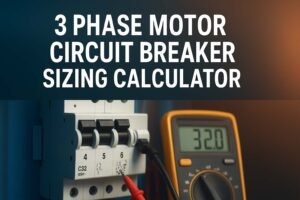
Easily determine the right breaker size with our 3 Phase Motor Circuit Breaker Sizing Calculator. Ensure proper motor protection, electrical safety, and efficiency with accurate calculations for industrial and commercial applications.
Price Currency: USD
Operating System: All
Application Category: UtilitiesApplication

